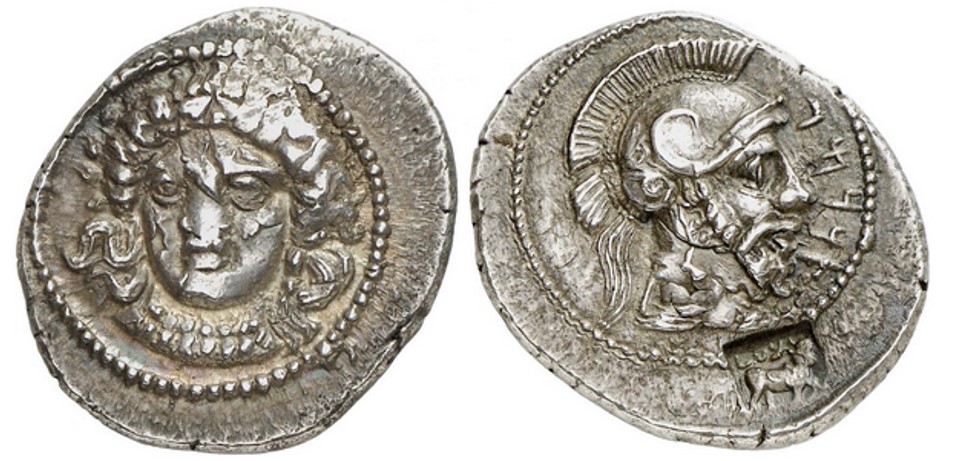378 BCE - 362 BCE | TRKMW (in Aramaic characters)
Overstriking coin
Tarsus_3129_Künker.jpg
Overstruck variety
Side Athena Apollo.jpg
[1]
|
|
Sale(s)Sale(s) ᵖ:
|
Künker, 312, 8 Oct. 2018, 2516
|
|
|
|
Description
| ObverseInscription or printing placed on the obverse.:
|
Female head facing slightly to left, hair in ampyx, wearing earring and necklace. Dotted border.
|
ReverseInscription or printing placed on the reverse.:
|
TRKMW (in Aramaic characters) (Aramaic) Bearded head right, wearing crested Attic helmet, drapery around neck. Border of dots.
|
Mint and issuing power
| MintIdentifies the place of manufacture or issue of a numismatic object.:
|
Tarsus
|
Ancient regionAncient region.
|
Cilicia
|
Modern countryModern country: Turkey
|
AuthorityIdentifies the issuing power. The authority can be "pretended" when the name or the portrait of X is on the coin but he/she was not the issuing power. It can also be "uncertain" when there is no mention of X on the coin but he/she was the issuing power according to the historical sources:
|
Persian Empire, Tarkumuwa (Datames), satrap of Cilicia
|
Chronology
| FromIdentifies the initial date in a range assigned in a numismatic context. 378 BCE toIdentifies the final date in a range assigned in a numismatic context.. 362 BCE
|
Classical 480-323 BC  periodTime period of the numismatic object. periodTime period of the numismatic object.
|
Physical description
MetalThe physical material (usually metal) from which an object is made.: Silver 
|
WeightWeight of the numismatic object (in grams). in grams: 10.9410.94 g <br />10,940 mg <br />
|
DenominationTerm indicating the value of a numismatic object. Examples: tetradrachm, chalkous, denarius.: double siglos 
|
|
|
|
StandardStandard.: Persian
|
References
Description
| ObverseInscription or printing placed on the obverse.:
|
Athena standing Athena left, holding Nike in right hand, resting left hand on shield. In field, pomegrenate. Border of dots.
|
ReverseInscription or printing placed on the reverse.:
|
Apollo standing left
|
Mint and issuing power
Chronology
| FromIdentifies the initial date in a range assigned in a numismatic context. 400 BCE toIdentifies the final date in a range assigned in a numismatic context.. 380 BCE
|
Classical 480-323 BC  periodTime period of the numismatic object. periodTime period of the numismatic object.
|
Physical description
| DenominationTerm indicating the value of a numismatic object. Examples: tetradrachm, chalkous, denarius. ᵖ:
|
double siglos 
|
StandardStandard. ᵖ:
|
Persian
|
References
References
- ^ Moysey, Robert A. (1986), "The Silver Issues of Pharnabazos and Datames from the Mint of Tarsus in Cilicia", American Numismatic Society Museum Notes, 31, p. 7-61, pl. 1-5.
- ^ Atlan, Sabahat (1967), Untersuchungen über die sidetischen Münzen des V. und IV. Jahrhunderts v. Chr., Ankara, 181 p., 12 pl.
- ^ Levante, Edoardo [with the collaboration of Peter Weiss] (2001), Sylloge nummorum graecorum. France. 3, Département des monnaies, médailles et antiques : Pamphylie, Pisidie, Lyaconie, Galatie, Paris-Zürich, Bibliothèque nationale de France-Numismatica Ars Classica, XXXIV + 293 p. and 146 pl.


